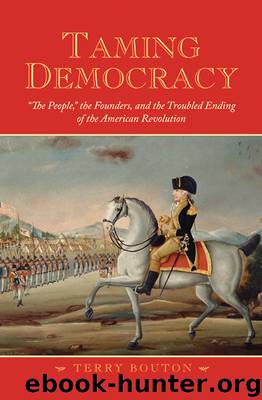Taming Democracy: “The People,” the Founders, and the Troubled Ending of the American Revolution by Terry Bouton

Author:Terry Bouton [Bouton, Terry]
Language: eng
Format: epub
Published: 0101-01-01T00:00:00+00:00
Ring Seven: The Delinquent Militia
Under such circumstances, what could the state do? Preventing this array of resistance was no simple matter. In most places, state leaders could not call out the militia to compel tax collection or to ensure the success of a sheriff’s auction precisely because, as in York County, it was militiamen who were leading the protests.
State leaders also had good reason to worry that their orders would be ignored given the militia’s lack of responsiveness when called out on several previous occasions. In these episodes, militiamen had rejected orders to march because they perceived the state’s use of the militia to be a violation of revolutionary principles. The most noteworthy cases involved militiamen who rebuffed state orders to oust settlers from Connecticut who were living in Pennsylvania’s Wyoming Valley (in the northeast portion of the state). Those orders were orchestrated by a powerful coalition of politician-speculators that cut across party lines: merchant-banker-politician Robert Morris, state comptroller general John Nicholson, banker-jurist James Wilson, and Philadelphia merchants William Bingham and Henry Drinker. These men had all heavily speculated in Wyoming lands and wanted the Connecticut settlers removed to protect their investments. Given the influence they wielded, these politicians easily convinced a majority of the Pennsylvania assembly to order militia units into Wyoming in 1784 to remove the so-called Connecticut claimants by force.41
In rejecting that call to arms, several county militias gave clear expression to popular ideals of the Revolution, complaining that they had been called to serve private, self-interested purposes rather than the public good. Thus, in August 1784, when the commander coordinating the Wyoming attack arrived in Northampton County, he discovered few soldiers willing to fight. “Upon our arrival at Easton,” he reported, “we found neither the temper nor preparation of the militia such as we had expected to find them.” He ordered Northampton County militia captains to call their companies together, but “not more than one third of the number . . . appeared at the place of Rendezvous & among these but very few declared themselves to be perfectly willing to go farther.” Instead, “we everywhere met the following objections: ‘that it was the quarrel of a set of landjobbers—that the whole County was not worth the life of a single man, or the labor of the many who were now called out to quiet it.” The militiamen claimed that they had been “drawn forth not merely to support the Laws but to extirpate the whole race of Connecticut claimants”—an objective they considered reprehensible and utterly inconsistent with the public good.42
In 1785, several militiamen in neighboring Berks County also refused to march. “To our Thoughts,” the men said, the Connecticut settlers were “Not Being our Enimies” and so it was wrong to go. They also complained that “the Poorer Sort of People were all ways Forced to Turn out” for militia service, while “the Wealthy of Good Estate” used their “Money” to exempt themselves. The commanding officer later complained that he had called out “two Classes
Download
This site does not store any files on its server. We only index and link to content provided by other sites. Please contact the content providers to delete copyright contents if any and email us, we'll remove relevant links or contents immediately.
| Anarchism | Communism & Socialism |
| Conservatism & Liberalism | Democracy |
| Fascism | Libertarianism |
| Nationalism | Radicalism |
| Utopian |
The Secret History by Donna Tartt(18846)
The Social Justice Warrior Handbook by Lisa De Pasquale(12141)
Thirteen Reasons Why by Jay Asher(8796)
This Is How You Lose Her by Junot Diaz(6794)
Weapons of Math Destruction by Cathy O'Neil(6146)
Zero to One by Peter Thiel(5686)
Beartown by Fredrik Backman(5599)
The Myth of the Strong Leader by Archie Brown(5425)
The Fire Next Time by James Baldwin(5249)
How Democracies Die by Steven Levitsky & Daniel Ziblatt(5128)
Promise Me, Dad by Joe Biden(5087)
Stone's Rules by Roger Stone(5026)
A Higher Loyalty: Truth, Lies, and Leadership by James Comey(4844)
100 Deadly Skills by Clint Emerson(4840)
Rise and Kill First by Ronen Bergman(4704)
Secrecy World by Jake Bernstein(4646)
The David Icke Guide to the Global Conspiracy (and how to end it) by David Icke(4625)
The Farm by Tom Rob Smith(4437)
The Doomsday Machine by Daniel Ellsberg(4416)
